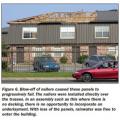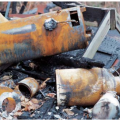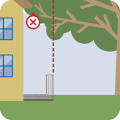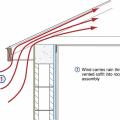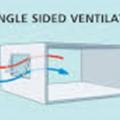Showing results 1151 - 1165 of 1165
Wrong – This multi family building appears to be done in traditional southwest architecture but the lack of useful overhangs, dark colored walls, and lack of tinting on windows will result in significant solar heat gain.
Wrong – This roof has no sheathing, when the metal panels blew off there was no secondary protection
Wrong – This roof membrane on a low slope roof is fluttering and may fail because it is not fully adhered and deck seams below are not sealed, allowing air to leak up into the assembly while the membrane is pulled up due to negative pressures from wind
Wrong – This standard air vent has become blocked by flood debris and is located at the top of the foundation wall; it should not be used as a flood vent
Wrong – This water heater was not braced; it fell during an earthquake and ruptured the gas line causing a house fire.
Wrong – Tree branches close to the house are prone to spreading crown fires to the house; the tree should be trimmed so that branches are at least 10 feet back from the red dashed line indicating the deck railing of the house.
Wrong – Wind-driven rain and wildfire embers can enter an attic through the soffit vents.
Wrong – Window not protected and failed due to windborne debris in hurricane force winds.
Wrong –The gate that was attached to the garage at the corner ignited and led the fire to the home, causing the damage seen here.
Wrong-The home was pulled off its masonry pier foundation during a coastal flood due to inadequate pier-to-beam connections.
Wrong-These masonry pier foundations were twisted and displaced by coastal storm surges in Long Beach, Mississippi.
Wrong: Closed-cell spray foam roof insulation was not thick enough to meet IRC levels so the foam surface is colder than the dew point of the interior air and condensation formed on surface of the foam
Wrong: Electrical components were installed near ground level and are likely to be flood damaged.
Wrong: Single sided ventilation without at least two windows, wing walls, and predictable wind directions is ineffective for generating wind-driven crossflow.
Wrong: The fiber-cement siding has cracked due to over-driven nails located too close to the edge of the board; these cracks provide a pathway for bulk water entry and offer little resistance to high winds.

